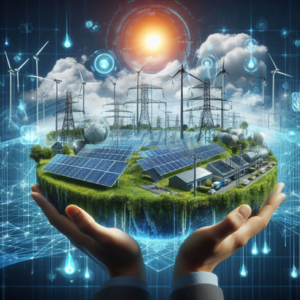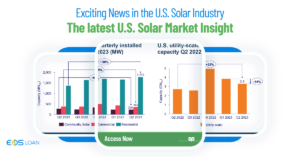Distributed generation (DG) of electrical energy generated through photovoltaic panels
According to ABSOLAR (2023), the solar energy sector, in Brazil, generated R$33 billion in investments in the first half of 2023, accumulating more than R$170 billion in new investments since 2012, R$47.9 billion in taxes generating one million jobs accumulated.
Avoiding the emission of 42.8 million tons of CO2 in electricity generation, which can also generate revenue in the carbon market.

The generation of electrical energy from photovoltaic panels is the fastest growing in Brazil, being the second largest source of generation with a capacity of 36 GW, around 16.1% of the national electrical production (Exame, 2023).
In September 2023, Brazil surpassed the mark of 7 gigawatts (GW) of increase in installed capacity, in the 208 factories opened this year. Wind and solar plants accounted for 89.2% of the growth in installed capacity in the year (ANEEL, 2023).
On the global stage, US$366 billion was invested in renewable energy (RE) in 2021 (REN21, 2022), which means that generation from renewable sources reached 69% of the increase in generation capacity in 2021.
According to Naval & Yusta (2021), most countries are migrating to a retail electricity trading market, mainly supplied through DG with renewable sources.
To improve efficiency and reduce the risks characterized by the massive introduction of RE into the energy system, there is a need to use system balancing mechanisms due to the intermittency of REs , especially wind and solar. It is in this context that virtual power plants (VPP) emerge.
An important advantage of VPPs is that they can sell energy on behalf of DG system owners.
Definition of Virtual Power Plants (VPP)
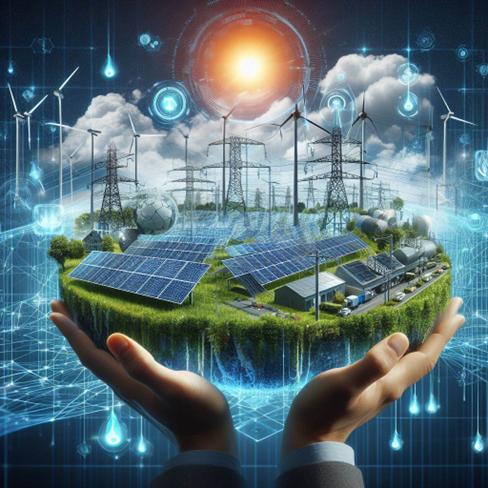
By definition, a VPP consists of the integration of a group of DG installations managed by a single control system with bidirectional communications between its components for more efficient operation.
An important characteristic of VPPs is their ability to participate directly in electricity markets to obtain greater economic and operational efficiency, through the so-called commercial (CVPP) and technical (TVPP) virtual power plants discussed in item 3.
More broadly, we can say that VPPs are used to manage distributed energy resources (DER):
1. Distributed generation;
2. Demand response;
3. Storage systems;
4. Energy efficiency;
5. Electric vehicles.
DERs can be used on both the energy demand and supply sides (BRADFORD & HOSKINS, 2013).
Importance of DG in the context of the energy transition
Energy transition is the transformation of the current energy matrix (generation and use of energy) to a matrix that reduces greenhouse gas (GHG) emissions with the aim of stabilizing the global temperature, which on the current trajectory could reach an increase of 4 degrees Celsius at the end of the century.
To achieve this, it is necessary to reduce the use of GHG emitting sources (coal, fuel oil, diesel oil) in electricity generation and increase the use of REs .
Other possibilities that have been discussed extensively are: the use of renewable or zero-carbon hydrogen (especially green and blue hydrogen) in various industrial processes and the use of large batteries for energy storage (EPE, 2023).
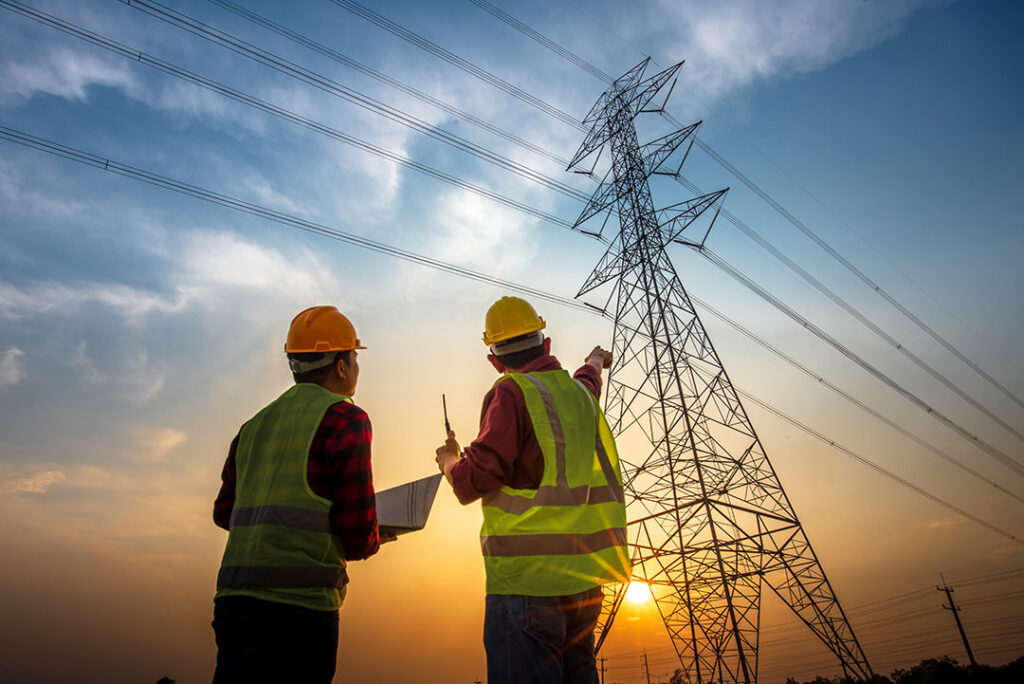
- Fundamentals of Virtual Power Plants
Developing distributed energy resources
Distributed generation
Is a system with small generation, located close to the load and connected directly to the distribution network and which adds several benefits such as: stability and reliability of the system, reduction or postponement of the need for investments in generation and transmission lines , transmission and distribution, diversification of the electrical matrix, reduction of technical losses and increased consumer participation in system expansion.
Demand response
The electricity sector has a synchronous coupling, that is, it requires a real-time balance between energy generation and consumption. Sudden variations in demand are capable of unbalancing generation and consumption.
Demand response programs bring many benefits such as low tariff rates , greater system reliability and reduced price volatility. Demand response programs can be based on prices (price variation per time) and tariff incentives that can be voluntary, mandatory or marked equilibrium.
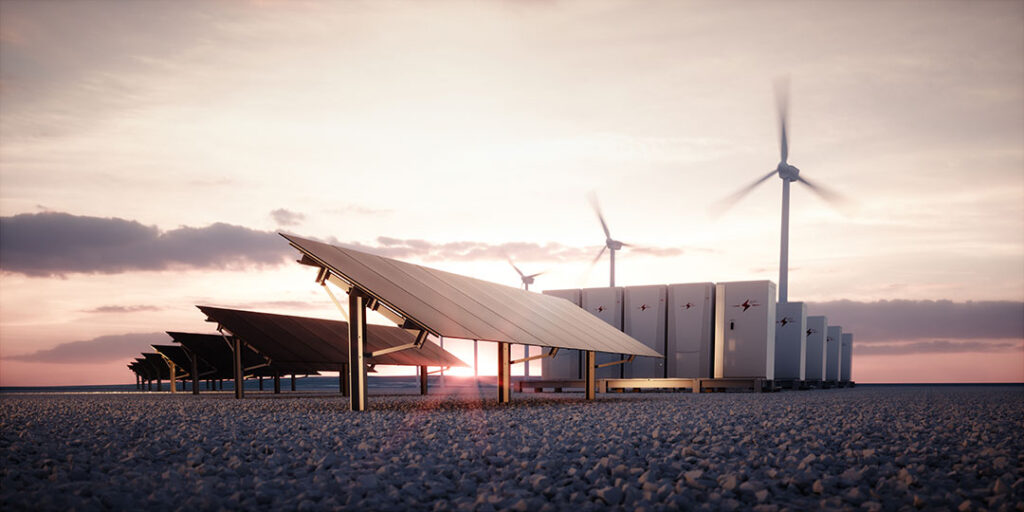
Storage systems
Energy storage systems are strong allies in the diffusion and penetration of renewable energy sources in the market, as they allow to mitigate the effects caused by the intermittent nature of these energy resources. In homes, the combination of a battery with solar panels allows the battery to be charged during the day and supply the property during peak demand hours with the most expensive energy. This type of installation allows the consumer to be protected from blackouts, with solar energy operating off-grid, and save even more on the electricity bill, reducing the use of electricity supplied by the distributor even at night (ABSOLAR, 2023b) .
Energy efficiency
Efficiency means doing more (or at least the same thing) with less, while maintaining comfort and quality. Energy efficiency means generating the same amount of energy with fewer natural resources or obtaining the same service with less energy. Energy efficiency is considered one of the most important DER, which with the development of technology combining low consumption and intelligent equipment, is capable of delaying infrastructure costs with the expansion of generation and transmission and distribution networks, in addition to reducing values of peak electrical energy demand, contributing to the safety and reliability of the system (EPE, 2023).
Electric vehicles (EV).
The production of electric vehicles has grown consistently and tends to be a relevant DER in the future, integrating micro grids and VPP. According to Siemens (Electric Car Future Predictions , nd. -b) EV sales have seen steady growth over the last five years. EVs are expected to equal sales of internal combustion engine vehicles by 2030 and surpass them by 2040. The increase in EV production and their connection to residential battery systems makes them a relevant DER.
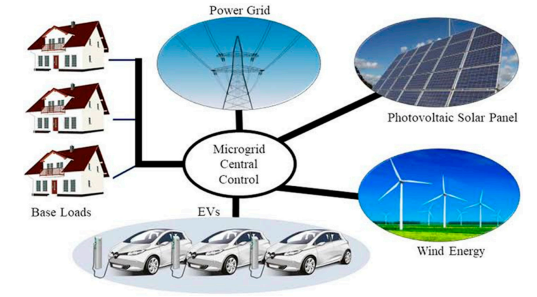
Figure 2 – VE as a component of a VPP. Translated from ( Ntombela et al., 2023)
Types of virtual power plants
Virtual power plants ( VPPCs ) fundamentally focus their operations on market participation in the electrical sector by optimizing production and supply with the electrical energy demand of their components. VPPTs offer ancillary services to the transmission network operator, controlling frequency and voltage levels.
According to Naval & Yusta (2021), by optimizing control and coordination between energy generation sources and the storage system, a VPP is able to satisfy electricity demand and obtain gains capable of giving it access to traditional markets. of energy, breaking barriers to the integration of renewable energy into the grid and helping it achieve sustainable development.

Figure 3 – Typical interaction diagram between a VPP, the energy market and the grid.
The main objective of VPPs is to optimize the management and scheduling of different generation facilities and the stability of the grid to maximize the VPP’s bottom line. VPPCs use models whose objective function aims to maximize the difference between costs and revenues from energy sales. Some models, in addition to maximizing profits, also seek to minimize GHG emissions simultaneously through multi-objective models.
Currently, most countries have already implemented liberalization processes and opening up to competition in their respective electricity markets. Naval & Yusta (2021) created a table with the different markets that VPPs can vary depending on the regulations of each country. Table 1 presents the translation of this table.
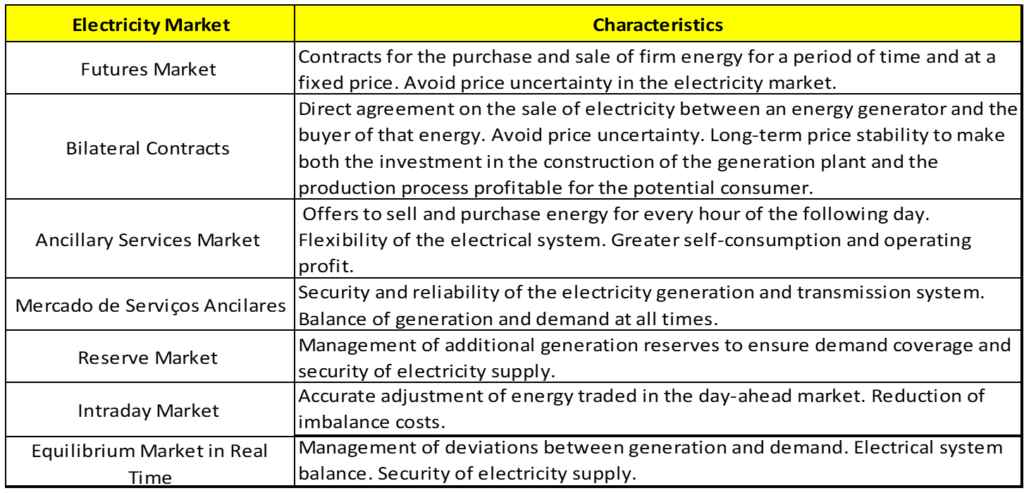
Table 1 – Types of electricity markets
The contract types varies according to the time of energy dispatch.
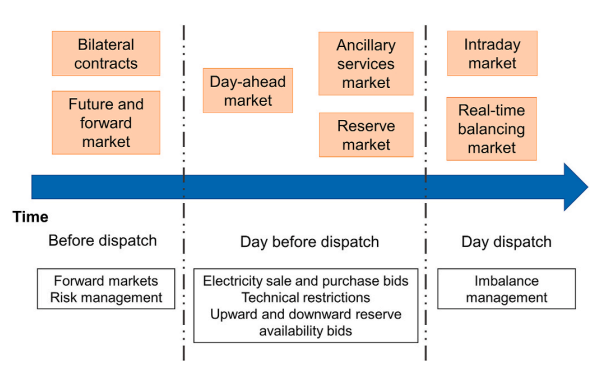
Figure 4, Naval & Yusta (2021) types of markets in relation to time and energy dispatch.
According to Naval & Yusta (2021) in recent years, there has been substantial growth in generation plants with renewable energy. To favor the integration of these plants into the electrical system, market mechanisms must provide greater flexibility to the electrical system and improve its ability to deal with the variability and uncertainty of renewable generation. This should ultimately ensure the security of electricity supply. For this reason, the increasing development of ancillary services and service markets and bilateral contracts is notable.
Trends in VPPs in Brazil
On June 17, 2021, ANEEL published Technical Note No. 0076-2021 to investigate regulatory models applicable to the Brazilian context for the insertion of DERs , microgrids and VPP based on best international practices and considering their potential impacts on the electricity sector (ANNEL, 2021).
The perspective is to insert VPP and DER in Brazil due to the modernization process of the Brazilian electricity sector and the sector’s decarbonization policies.
Among the modernization policies in Brazil are the opening of the Electric Energy Market, generating greater competitiveness and attractiveness in prices, giving the consumer greater power of choice since they are given free negotiation in relation to prices.

The electricity sector is preparing for a significant change from 2024, when a new rule comes into force that will allow all consumers connected to a voltage above 2.3 kilovolts (kV), known as group A, to choose their electricity supplier , adhering to the so-called free energy market. In practice, this means that companies with electricity bills exceeding R$10,000 will be able to change their energy supplier ( Infomoney , 2023).
VPPs are technology-intensive solutions. The development of applications created through artificial intelligence with blockchain technology and cloud computing promises to transform business models, giving more freedom, with lower costs and much faster transactions. With all these modernization policies and the use of disruptive technologies, one can expect a change in the general panorama of distributors, incorporating the three Ds of the energy transition: decarbonization, decentralization and digitalization.
Final considerations
This study discussed the transformation and modernization of the energy sector, focusing on the role of Virtual Power Plants (VPPs) as an innovative solution to optimize the generation and distribution of electrical energy from renewable sources. Through distributed generation (DG), through photovoltaic, wind, biomass and other sources, VPPs emerge as a model capable of managing distributed energy resources efficiently, reducing costs, improving grid stability and promoting a sustainable energy transition.
The expansion of this solar energy sector stood out, which, in the first half of 2023, generated investments of around R$33 billion in Brazil, accumulating a value of more than R$170 billion in new investments since 2012 and contributing around R$ $479 billion in tax revenue. ABSOLAR estimates that in 2024 more than 281.6 thousand new jobs will be created by the sector. As a contribution to combating climate change, photovoltaic generation contributes to a reduction of 42.8 million tons of CO2 in electricity generation, according to (ABSOLAR, 2023).

On the global stage, there is exponential growth in the production and adoption of electric vehicles (EV) and the evolution of battery systems as critical components of Distributed Energy Resources ( DERs ), pointing to a future where the integration of microgrids and VPPs could transform significantly the distribution structure and energy consumption.
This scenario is fueled by consistently growing EV production, predicted to equal sales of internal combustion vehicles by 2030 and surpass them by 2040, a trend that reinforces the relevance of EVs as an essential DER in the transition to a sustainable energy matrix (Electric Car Future Predictions , n.d. -b).
Finally, the document addresses trends in VPPs in Brazil, considering the modernization policies of the electrical sector and the potential for insertion of VPPs and DERs in the Brazilian market.
The expectation of significant changes from 2024 onwards, with the opening of the electricity market and the adoption of disruptive technologies, such as artificial intelligence and blockchain, signals a profound transformation in the country’s energy landscape.
In conclusion, the article solidifies the position of VPPs as fundamental pillars in the renewable energy sector revolution.
By leveraging distributed generation, enhancing the use of innovative technologies and promoting the integration of sustainable energy resources, VPPs are presented as vital solutions to overcome the challenges of the energy transition.
They represent a remarkable step forward towards achieving a resilient, efficient and low-carbon energy future, marking a progressive path towards global sustainability.
References
ABSOLATE. (2023b, November 29). Falling prices and regulation should boost the use of residential batteries – ABSOLAR. https://www.absolar.org.br/noticia/queda-de-precos-e-regulacao-devem-impulsionar-uso-de-baterias-residênios/
ABSOLAR (2024) – Brazilian Association of Photovoltaic Solar Energy. Available at: https://www.absolar.org.br/mercado/infografico/ . Accessed on 02/08/2024.
AGUIAR, FM ( 2022). “Study for the Application of Virtual Energy Plants in Brazil.” 2022. Available at: http://hdl.handle.net/10183/235937 . Accessed on 03/27/2024.
BRADFORD, T. HOSKINS, A. (2013) Valuing Distributed Energy: Economic and Regulatory Challenges. Available at: https://travisbradford.files.wordpress.com/2012/01/de-whitepaper-final-0426.pdf Accessed on 03/27/2024
EPE – Energy Research Company (2023). Climate change and energy transition. Available at: https://www.epe.gov.br/pt/abcdenergia/clima-e-energia. Accessed on 03/08/2024 .
Electric car future predictions . ( nd. -b). Siemens Resource Center. https://resources.sw.siemens.com/en-US/white-paper-electric-car-future-prediction
ExamE (2023). ESG 2023 Retrospective: the turning point for solar energy in Brazil. Available at: https://exame.com/esg/retrospectiva-esg-2023-o-ano-da-virada-para-a-energia-solar-no-brasil/ . Accessed on 03/15/2024.
Infomoney (2023,). Opening of the free energy market attracts consumers and moves electricity. InfoMoney . https://www.infomoney.com.br/business/abertura-do-mercado-livre-de-energia-atrai-consumidores-e-movimenta-eletricas . Access on 03/28/2024.
Naval, N., & Yusta, J. M. (2021). Virtual power plant models and electricity markets-A review. Renewable and Sustainable Energy Reviews, 149, 111393.
Ntombela, M., Musasa, K., & Moloi, K. (2023). A comprehensive review of the incorporation of electric vehicles and renewable energy distributed generation regarding smart grids. World Electric Vehicle Journal , 14(7), 176. https://doi.org/10.3390/wevj14070176



